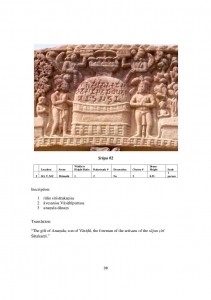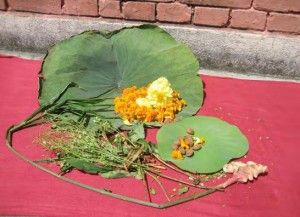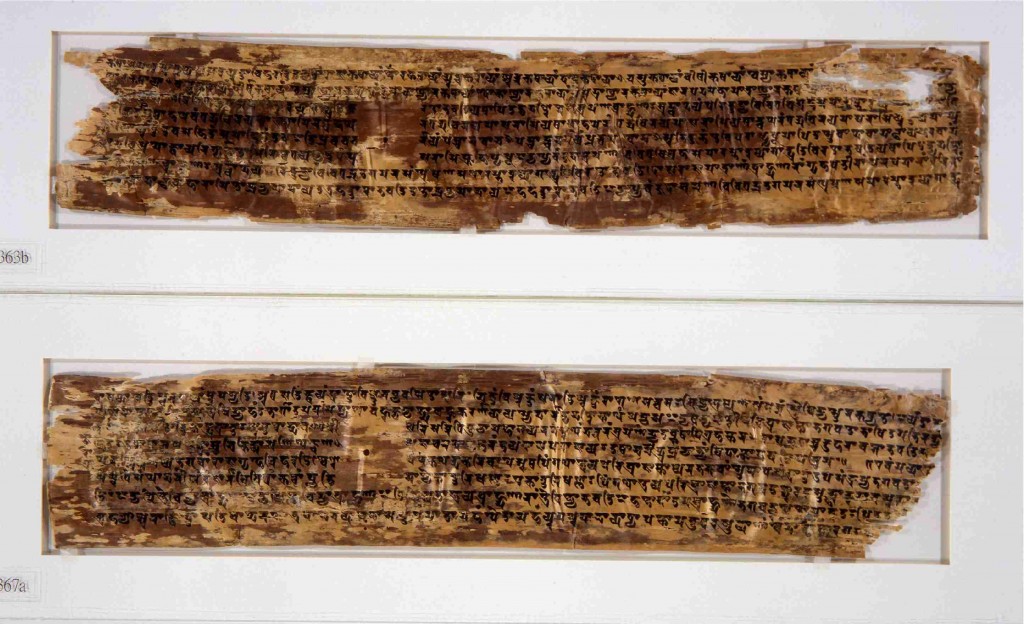Milligan, Matthew David. ‘A Study of Inscribed Reliefs within the Context of Donative Inscriptions at Sanchi’. M. A. thesis, University of Texas at Austin, 2010. [official site URI / PDF]
From the abstract

Milligan, Matthew David. ‘A Study of Inscribed Reliefs within the Context of Donative Inscriptions at Sanchi’. M. A. thesis, University of Texas at Austin, 2010. [official site URI / PDF]

Roger Wright. ‘The Guhyasamāja Piṇḍikṛta-sādhana and its context’. MA thesis (Religions), School of Oriental and African Studies, 2010. [PDF (‘internet version’)]
This paper analyses and comments on the Piṇḍikṛta-sādhana, a ritual practice manual for the Guhyasamāja Highest Yoga Tantra, attributed to Nāgārjuna. It is based on a correlated translation of the Sanskrit and Tibetan versions of the text prepared for the purpose. […]
Particular attention has been given to making the translation of the visualizations of the architecture and the deities themselves clear by providing tables and illustrations. The philosophical background of the text is investigated and the way in which that was subtly altered by subsequent commentators when it no longer fitted the later “philosophical climate” is made clear. The continuity of the practice is discussed, from its inception to the present day.

Astrid Zotter (née Krause). ‘Pūjā-Blüten in Nepal: Bestimmungen des Puṣpacintāmaṇi‘. Universität Leipzig: PhD dissertation, 2009. [In German; PDF] 408 pp., illus.
Dr. Zotter’s dissertation on the medieval flower-offering manual Puṣpacintāmaṇi presents a critical edition of the Sanskrit and Newar texts, and discusses the role of this important work in Nepal from the reign of Pratap Malla onwards. This is a new milestone in Newar studies, and more generally another welcome contribution to the study of the transmission of Sanskrit texts and vernacular translations in medieval South Asia. A few words from the abstract (roughly translated):
The Sanskrit text Puṣpacintāmaṇi (PuCi) treats flower offerings (upacāra) in the most important worship ritual of Hinduism, the pūjā. In 400 verses, about 200 names of flowers prescribed as appropriate or inappropriate gifts for various deities and pūjās are listed. The text is a compilation (nibandha), in which the contents of 47 named source texts are reported. […]
The aim of the thesis is not only to edit this text, which was published for the first time in 1966, anew on the basis of all traditional manuscripts and to translate it for the first time, but also to fit it into its context. Here, the context of the historical development of the text, the position of the PuCi in the textual tradition and the varieties of interpretation are taken into account. […] Continue reading “Zotter, ‘Pūjā-Blüten in Nepal’; on the Puṣpacintāmaṇi (2009)”

Four groups, formed around each of the four major canonical languages of Buddhism — Sanskrit, Chinese, Tibetan and Pāli — are now meeting at Mahachulalongkorn Vidyalaya, Bangkok, under the sponsorship of the International Association of Buddhist Universities. There they are hammering out plans to create a Union Catalogue of Buddhist Texts (UCBT), to be made freely available online.
More information (and snapshots of possibly familiar faces) can be found at the University’s website, here.
Andrey Klebanov. The *Nepalese Version of the Suśrutasaṃhitā and its Interrelation with Buddhism and the Buddhists. M. A. thesis, University of Hamburg, 2010. 223 pp.
Continue reading “Klebanov, ‘Suśrutasaṃhitā & Buddhists’ (2010)”
Jens Braarvig and Fredrik Liland, with contributions by Jens-Uwe Hartmann, Kazunobu Matsuda, Richard Salomon, and Lore Sander. Traces of Gandharān Buddhism. An Exhibition of Ancient Buddhist Manuscripts in the Schøyen Collection. Oslo: Hermes Publishing, in collaboration with Amarin Printing and Publishing Public Co. Ltd, Bangkok. 2010. xxxiv+101pp. [PDF (80 MB)].
This lavishly illustrated — and even more importantly, thoroughly researched — catalogue, published to accompany an exhibition of Afghan Buddhist manuscripts in Thailand, will surely be of interest to any serious scholar of Buddhism. Braarvig notes: “it is thus an important task to help preserve this dharmakāya [manuscript heritage] of the Buddha”. (One could add that Thailand, where a formerly practiced Sanskritic tradition has been completely lost, is probably not the place to find a receptive audience for such sentiments.)
Two dissertations on the eighth-century Śaiva author Sadyojyoti, both supervised by Krishna Sivaraman, have recently become available online at McMaster University:
Leon E. Hannotte. Philosophy of God in Kashmir Śaiva Dualism: Sadyojyoti and His Commentators. PhD Diss., McMaster University, 1987. Open Dissertations and Theses, Paper 2089. [abstract & pdf]
Wayne Andrew Borody. The Doctrine of Empirical Consciousness in the Bhoga Kārikā. PhD Diss., McMaster University, 1988. Open Dissertations and Theses, Paper 2073. [abstract & PDF]
For students of late Indian Buddhism, Sadyojyoti is a person of interest, given his advocacy of epistemes such as the sākārajñānavāda / nirākārajñānavāda dyad, which was already known to Kamalaśīla, as well as to some later Buddhist authors.
Hannotte’s dissertation was published by the National Library of Canada in 1989, and as F. S. kindly pointed out to me, Borody’s dissertation finally came out with Motilal Banarsidass in 2005. Nonetheless, it is handy to be able to freely access both dissertations.
Theodore Benke. The Śūdrācāraśiromaṇi of Kṛṣṇa Śeṣa: A 16th Century Manual of Dharma for Śūdras. PhD diss., University of Pennsylvania, 2010. [abstract & official site / PDF]
“From the fourteenth to the seventeenth century C.E., a śāstra of a new type on the topic of Śūdras was composed and circulated among Dharmaśāstrins. […] Śūdradharma texts were one response of the Brahmin intellectual elite to the challenges to traditional dharma and dominance arising from the changing socio-economic conditions of Sultanate and Mughal India. They represent a shift in Dharmashastric discourse from the ritual exclusion of Śūdras as the sign of their social subjection to fuller integration into the Brahmanical fold. […] These śūdradharma texts were primarily concerned with the ritual life of Śūdras—the rites, sacraments, and forms of religious knowledge to which they were entitled in śruti and smṛti. But they also included expositions on the generation of Śūdra jātis according to the theory of varṇasaṅkara and descriptions of the ways of life and occupations of Śūdras. This is a study and translation of one of these texts, the Śūdrācāraśiromaṇi of Kṛṣṇa Śeṣa, among the most brilliant and eminent paṇḍits of late medieval Sanskrit, celebrated as both grammarian and poet.”
Green, Phillip Scott Ellis. Female Imagery in the Avadānaśataka. M. A. diss., University of Florida, 2007. [PDF]
Includes English translations of Avadānaśataka 77 & 78. Green dedicates his thesis, fittingly enough, to Āryatārā.
Peipina, Lita. The Piṃgalātreya sūtra of the (Mūla)sarvāstivādins: its edition and study. Investigation of the Piṃgalātreya sūtra’s status within the Dīrghāgama “Collection of Long (Discourses of the Buddha)”. MA diss., University of Oslo, 2008. 85 pp. [abstract/PDF]
Contains a diplomatic edition and critical edition of the Gandhāran MS discovered in 1999. Supervised by Jens Braarvig.